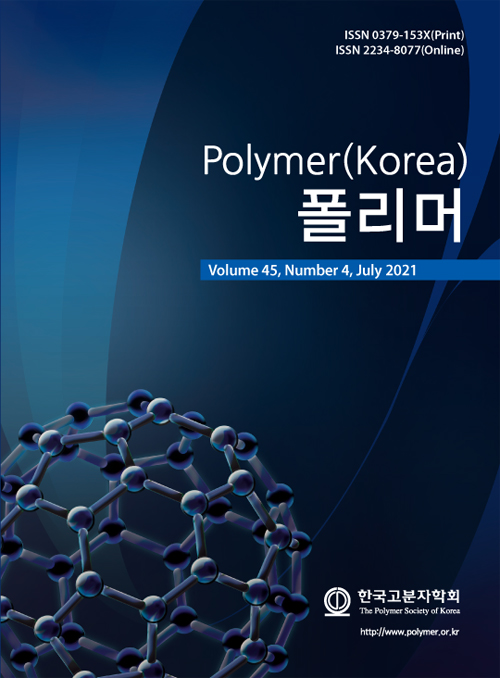- Synthesis, Structural, Time-Dependent Density-Functional Theory, Thermal Annealing and Optical Properties for Doped Polymer Nanostructured Thin Films as Optoelectronic Devices
Department of Chemistry, Faculty of Science, Northern Border University, 13211 Arar, Saudi Arabia
*Chemical and Materials Engineering Department, King Abdulaziz University, Rabigh 21911, Saudi Arabia
**Department of Chemistry, Faculty of Science, 23 December Street, 42521, Port-Said University, Port-Said, Egypt- 광전자소자로 이용가능한 나노구조 poly(4-phenylenediamine-co-2-aminophenol) 박막의 제조 및 분석
Reproduction, stored in a retrieval system, or transmitted in any form of any part of this publication is permitted only by written permission from the Polymer Society of Korea.
The dependence of structural and optical characteristics on the thermal annealing of a doped poly(4-phenylenediamine-co-2-aminophenol) nanostructured thin film [P4D2AP]TF as a doped polymer conductor nanostructured thin film was studied. [P4D2AP]TF was fabricated as a thin film (100 ± 2 nm) using the spin coating method. Various characterization methods for [P4A2AP]TF like Fourier-transform infrared spectroscopy (FTIR), ultraviolet-visible spectroscopic (UV-Vis), thermogravimetric analysis (TGA), and optical characteristics have been studied. The resulted X-ray diffraction (XRD) and scanning electron microscope (SEM) data have been employed to study interface composites. Density functional theory (DFT) was used for optimization by atomic orbital DFT code (DMol3) and Cambridge serial total energy package (CASTEP). Spectroscopic and structural characteristics for the thin film have confirmed the chemical composition and XRD observations revealed the same crystal structure. The fabricated film was annealed in the air for 1h at 100 and 200 oC. XRD examination of [P4D2AP]TF displayed that symmetry is an orthorhombic with a space group (Pmcn). The optical characteristics demonstrated that the thin film has a relatively high absorbance of 95%. The calculated energy gaps are 2.523 eV and 2.504 eV for DFT and experimental, respectively. In addition, the optoelectrical parameters of the film have been calculated for absorption index (k(λ)), refractive index (n(λ)), dielectric constant, and optical conductivity. CASTEP simulated values are consistent with the experimental values for optical parameters of [P4A2AP]TF. The findings of the structural and optical characteristics described the fabricated thin film can be utilized as a candidate material for optoelectronic devices and solar cells.
Keywords: synthesized poly(4-phenylenediamine-co-2-aminophenol) nanostructured thin film, X-ray diffraction, scanning electron microscope, time-dependent density-functional theory, thermal annealing, optical characteristics.
- Polymer(Korea) 폴리머
- Frequency : Bimonthly(odd)
ISSN 0379-153X(Print)
ISSN 2234-8077(Online)
Abbr. Polym. Korea - 2023 Impact Factor : 0.4
- Indexed in SCIE
 This Article
This Article
-
2021; 45(4): 541-551
Published online Jul 25, 2021
- 10.7317/pk.2021.45.4.541
- Received on Feb 11, 2021
- Revised on Mar 14, 2021
- Accepted on Apr 4, 2021
 Correspondence to
Correspondence to
- Al-Hossainy
-
Department of Chemistry, Faculty of Science, Northern Border University, 13211 Arar, Saudi Arabia
- E-mail: ahmed73chem@scinv.au.edu.eg









 Copyright(c) The Polymer Society of Korea. All right reserved.
Copyright(c) The Polymer Society of Korea. All right reserved.